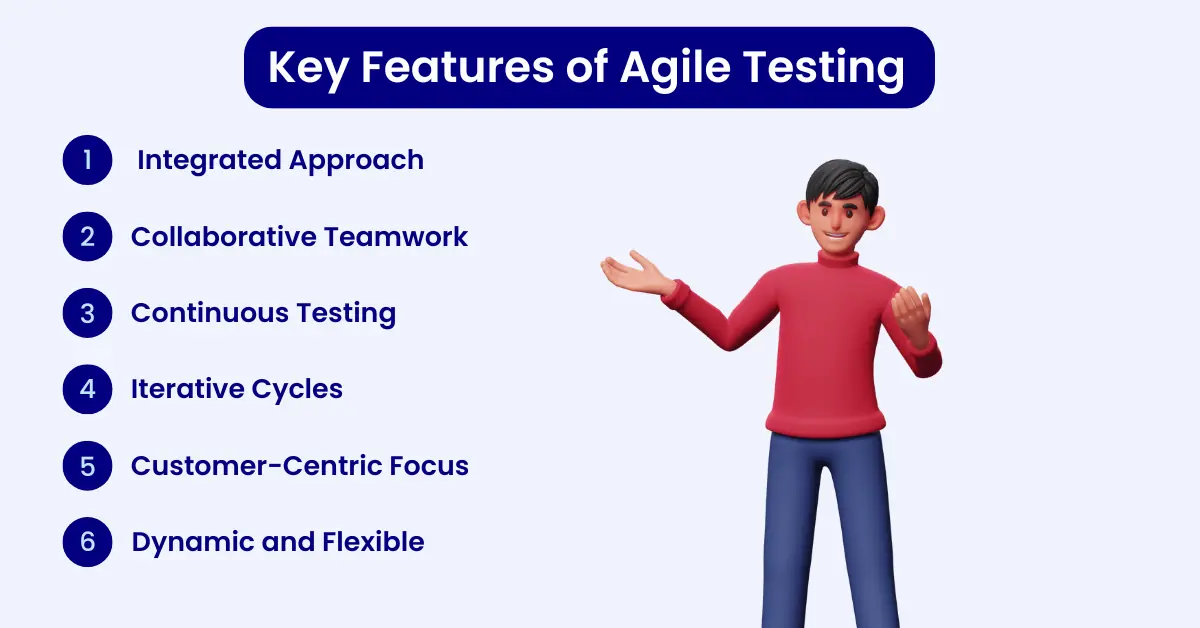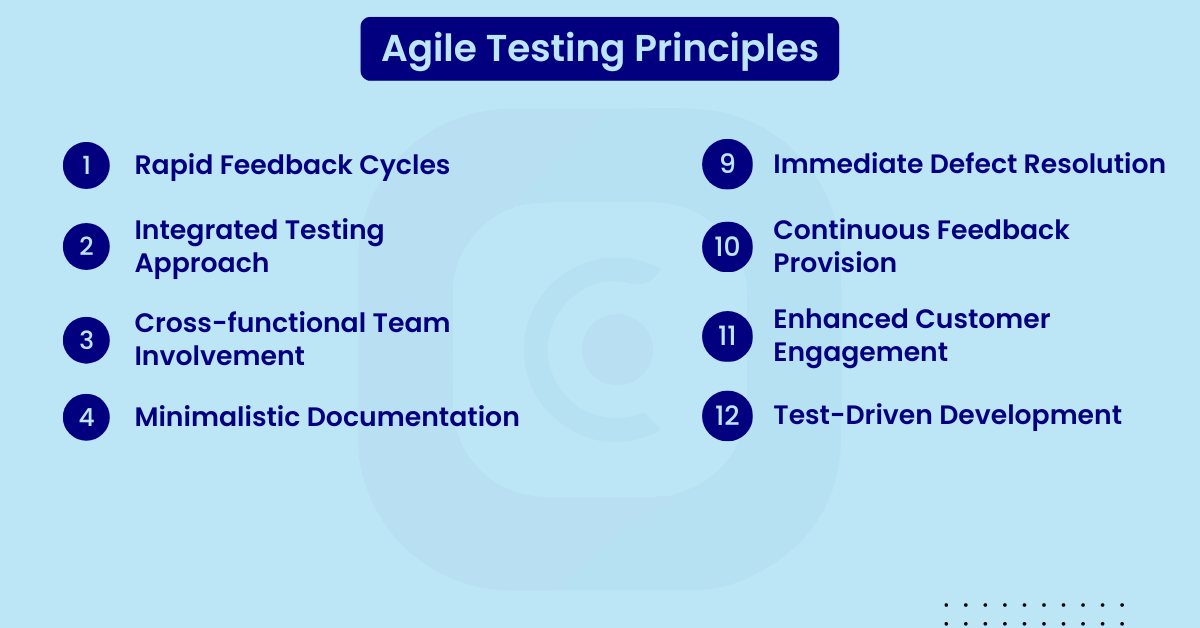Mastering Agile Testing: Key Principles and Best Practices in Agile Methodology

Agile is a well-known project management framework used in software development. Agile software testing is a method that helps developers continuously and quickly check their code. It also allows testers to quickly hear back from customers. In agile testing, different team members have specific roles and responsibilities. In this article, we’ll explain everything you need to know about Agile software testing.
What is Agile Testing?
Agile Testing is a type of software testing that follows the principles of agile software development to test the software application. All project team members, including special experts and testers, are part of agile testing. Agile testing is not a separate step, it happens alongside other development phases like requirements, design, coding, and test case creation. It occurs simultaneously throughout the entire Development Life Cycle. Agile testers work closely with the development team to build software according to customer requirements with improved design, making better code possible. The agile testing team functions as a single unit with the goal of achieving quality. Agile Testing has shorter time frames called iterations or loops. This methodology is also known as the delivery-driven approach because it predicts workable products in less time.
Agile testing is a flexible and dynamic form of testing. It happens regularly in every iteration of the Software Development Lifecycle (SDLC). Customer satisfaction is the main focus for agile test engineers throughout the agile testing process.
Key Features of Agile Testing

1. Integrated Approach
Testing is seamlessly incorporated into every stage of the software development process, ensuring that the software aligns with customer requirements and quality standards from the outset.
2. Collaborative Teamwork
Agile testing involves all project team members, fostering a collaborative environment where the team collectively aims for quality assurance and adherence to customer needs.
3. Continuous Testing
Testing is an ongoing activity throughout the development life cycle, allowing for immediate detection and resolution of issues, leading to a more refined and reliable software product.
4. Iterative Cycles
Agile testing adopts shorter time frames, known as iterations or loops, facilitating a quick turnaround and enabling the team to deliver workable products in a relatively short duration.
5. Customer-Centric Focus
Customer satisfaction is paramount in agile testing. Test engineers prioritize customer feedback and requirements, ensuring that the final product aligns closely with user expectations.
6. Dynamic and Flexible
Agile testing is characterized by its informal and dynamic nature. It adapts to changes swiftly and is performed regularly during each iteration of the Software Development Life Cycle (SDLC).
Agile Testing Principles

1. Rapid Feedback Cycles
Agile Testing facilitates immediate insights into product development and quality at each iteration. This rapid feedback loop significantly decreases the time required to respond to feedback and reduces the costs associated with making fixes.
2. Integrated Testing Approach
Testing in Agile is not a separate stage but occurs concurrently with the development phase. This ensures that features developed in a given iteration are fully tested and confirmed, avoiding the backlog of untested features.
3. Cross-functional Team Involvement
Agile testing mandates the active participation of every member from both the development and testing teams, promoting a collaborative environment that includes various developers and domain experts.
4. Minimalistic Documentation
Rather than extensive test documentation, agile testers employ lightweight, reusable checklists. These checklists guide the testing process, focusing on the core objectives of tests and sidestepping unnecessary details.
5. Immediate Defect Resolution
Detected defects are rectified within the same iteration, promoting a clean and refined codebase at every stage of the development process.
6. Continuous Feedback Provision
Agile testing is instrumental in providing consistent feedback, ensuring that the product continually aligns with business objectives and user requirements.
7. Enhanced Customer Engagement
Customers are actively involved throughout the Agile development cycle, allowing them to modify and update requirements as needed. This ongoing interaction ensures that the final product aligns closely with customer needs and expectations.
8. Test-Driven Development
Testing in Agile occurs alongside the development process, effectively shortening the overall development timeline. This stands in contrast to traditional methodologies where testing is typically conducted post-development.

An Overview of Prominent Agile Methodologies
1. Test-Driven Development (TDD)
TDD is a cyclical software development methodology emphasizing the formulation of unit tests prior to actual code construction. This method intertwines coding, unit test creation, and code refactoring into a cohesive, iterative process.
2. Behavior-Driven Development (BDD)
BDD is a specialized form of Agile testing centered on defining and constructing applications based on expected user behaviors. It promotes an integrative approach involving developers, quality assurance specialists, and stakeholders to ensure alignment with user expectations.
3. Exploratory Testing
This testing paradigm grants testers autonomy to navigate through the codebase, enabling a dynamic and thorough exploration of software functionalities. It’s instrumental in unveiling unforeseen risks and examining each facet of software performance.
4. Acceptance Test-Driven Development (ATDD)
ATDD fosters a collaborative environment where developers, testers, and stakeholders collectively deliberate on requirements and potential challenges, aiming to preemptively address issues prior to the onset of coding.
5. Extreme Programming (XP)
XP is a customer-centric methodology dedicated to delivering high-quality products that precisely meet customer needs and expectations. It emphasizes frequent releases and iterative development.
6. Session-Based Testing
This structured approach to exploratory testing is segmented into distinct, uninterrupted sessions, typically ranging from 45 to 90 minutes. Testers document their findings and test strategies in a charter document, ensuring a methodical exploration of the software.
7. Dynamic Software Development Method (DSDM)
DSDM is an Agile project delivery framework designed to support the rapid construction and ongoing evolution of systems, fostering collaboration among users, developers, and testers.
8. Crystal Methodologies
This collection of methodologies prioritizes human interaction and collaboration over rigid processes and tools. The applicability of Crystal methodologies is determined based on factors such as team size, project criticality, and priority.
A Closer Look at the Agile Testing Life Cycle
Impact Assessment
Also known as the feedback phase, this initial stage involves gathering inputs and reactions from users and stakeholders. The insights garnered here guide test engineers in formulating specific objectives for subsequent phases.
Agile Testing Planning
During this phase, a collaborative synergy is fostered among developers, customers, test engineers, and stakeholders. The focus here is to meticulously chart out the testing process, schedule regular progress meetings, and establish clear deliverables.
Release Readiness
Positioned as the third phase, this stage is dedicated to a comprehensive evaluation of developed features. Test engineers rigorously assess whether these features are primed for live deployment or if they require additional refinement in the previous development phase.
Daily Scrums
Characterized by daily meetings, this phase is instrumental in maintaining a pulse on the ongoing testing activities. These daily gatherings are pivotal for setting immediate objectives and ensuring that test engineers are acutely aware of the current testing status.
Test Agility Review
Culminating the Agile Testing Life Cycle, this final phase entails weekly engagements with stakeholders. The objective is to critically evaluate and measure the testing progress against the predefined goals, ensuring alignment with project milestones.
Understanding the Structure of an Agile Test Plan
An Agile Test Plan is a comprehensive blueprint that outlines the testing activities for a specific iteration, detailing the types of tests to be conducted, requirements for test data, environments involved, and expected outcomes. This plan is dynamically crafted and frequently updated to align with each release cycle. Key components of an Agile Test Plan include:
- Test Scope: Defines the boundaries and extent of the testing activities.
- Testing Tools: Enumerates the instruments and software utilized in the testing process.
- Data and Configuration: Specifies the test data and settings required to execute the tests.
- Testing Approaches and Strategies: Describes the methodologies and tactics employed during testing.
- Skill Requirements: Identifies the expertise and competencies necessary for the testing team.
- Functionality Testing: Outlines the new features and functionalities subjected to testing.
- Testing Levels or Types: Categorizes tests based on feature complexity and testing objectives.
- Resource Allocation: Details the human and material resources allocated for testing.
- Deliverables and Milestones: Highlights the expected outcomes and significant checkpoints within the testing timeline.
- Infrastructure Considerations: Addresses the hardware and network requirements for testing.
- Load or Performance Testing: Focuses on evaluating the system’s behavior under varying levels of demand.
- Mitigation or Risk Plan: Outlines strategies to address potential challenges and risks in the testing process.
The Double-Edged Sword of Agile Testing: Benefits and Limitations
Benefits of Agile Testing
- Time and Cost Efficiency: Agile testing enhances cost transparency, leading to significant time and financial savings.
- Reduced Documentation: Agile testing streamlines the process by minimizing the need for extensive documentation.
- Software Productivity Enhancement: It contributes to minimizing errors, elevating product quality, and boosting overall software productivity.
- Increased Efficiency: The division of work into smaller segments allows developers to concentrate on each part sequentially, fostering meticulous attention to detail, early inconsistency detection, and heightened efficiency.
- Product Quality Improvement: Regular feedback from users and stakeholders during the agile testing process plays a crucial role in refining software product quality.
Limitations of Agile Testing
- Risk of Project Failure: Agile testing can be vulnerable to project setbacks, especially if team members exit the project.
- Limited Documentation: The lean approach to documentation in agile testing can lead to challenges in predicting outcomes due to the absence of detailed conditions and requirements.
- Potential for New Bugs: The iterative nature of bug fixes, alterations, and releases in agile software testing may inadvertently introduce new bugs into the system.
- Challenges in Initial Planning: The flexible framework of agile testing makes it difficult to precisely predict aspects such as cost, time, and required resources at the project’s inception.
- Undefined Project Conclusion: Minimal initial planning and the absence of a clear vision for the final product in agile testing can lead to deviations from the intended product path and an indeterminate project endpoint.

Challenges and Risks in Agile Testing
In Agile Testing, several obstacles and potential pitfalls can impact the process, requiring strategic attention and proactive management:
- 1. Evolving Requirements: Changes in project specifications, particularly late in a sprint, can result in additional workload for teams in the subsequent sprints, disrupting the testing flow.
- 2. Test Coverage Adequacy: The fluid nature of Agile requirements, coupled with continuous integration, may lead to overlooked critical test cases. Employing agile test metrics for tracking test coverage is essential to ensure thorough testing.
- 3. Tester Skill Set: Testers may sometimes lack the proficiency in specialized testing like API and Integration testing, risking critical test case omissions. Targeted training programs can bridge this skill gap.
- 4. Documentation Scarcity: Agile’s minimalist documentation approach can escalate the complexity of QA tasks, demanding more intuitive and efficient testing strategies.
- 5. Performance and User Alignment: Focusing solely on specification requirements without a deep understanding of end-user needs can lead to performance bottlenecks, making load testing tools crucial for identifying and addressing these issues.
- 6. Defect Discovery Timing: Identifying defects during the late stages, such as production or testing, can pose significant rectification challenges, emphasizing the need for early and continuous testing.
- 7. Test Prioritization: Time constraints and the complexity of certain test cases may lead to the deferment of some non-functional tests, potentially introducing hard-to-fix bugs later on.
- 8. Automated UI Execution: While providing valuable insights, automated UI tests are often slow to execute and expensive to develop, necessitating a balance between automated and manual testing efforts.
- 9. Diverse Testing Approach: Ensuring product quality requires a mix of different testing types and levels, calling for a well-rounded and flexible testing strategy.
- 10. Automation Test Planning: Inadequate or rushed planning of automation tests can lead to failures, underlining the importance of a well-thought-out automation strategy.
Supercharge Your Revenue Generation with OneClick’s Agile Expertise
OneClick’s Agile software development team is all about speed, adaptability, and delivering exceptional results. With over a decade of experience, we create personalized solutions to keep your business ahead in today’s fast-paced market. At OneClick Agile software development company, we emphasize transparent communication, unwavering client satisfaction, and a cyclical development process. These core values ensure that your project remains agile and can swiftly adjust to your evolving requirements. Join hands with OneClick and witness the metamorphosis of your business, steered by our resolute pursuit of excellence.





